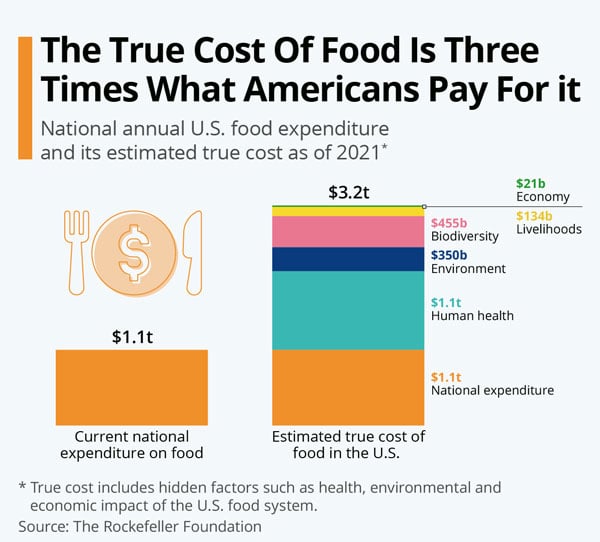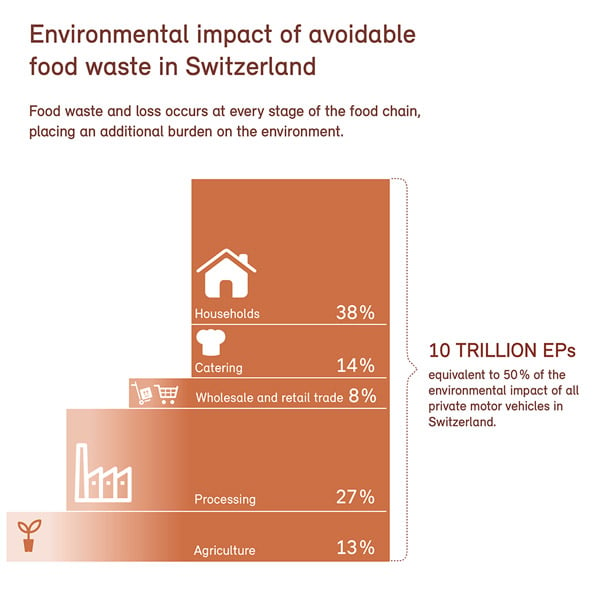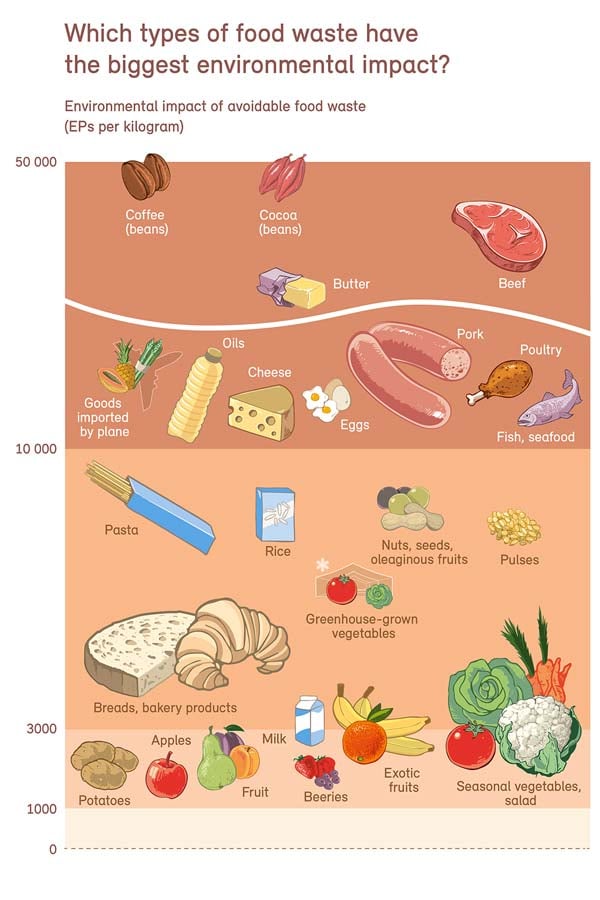 Reducing food waste is a global, multidimensional challenge, but what can hotels, restaurants and hospitality schools specifically do to be more mindful of its role in educating the future generations? Addressing the food waste challenge requires both a paradigmatic change toward food and a swift change in how food waste is managed in businesses and educational institutions.
Reducing food waste is a global, multidimensional challenge, but what can hotels, restaurants and hospitality schools specifically do to be more mindful of its role in educating the future generations? Addressing the food waste challenge requires both a paradigmatic change toward food and a swift change in how food waste is managed in businesses and educational institutions.
The true cost of food
Current food systems are a major contributor to global warming – 27.6% of global GHG emissions. Modern, industrialized and highly processed food is also a major cause for non-communicable diseases such as obesity, certain types of diabetes, and cardiovascular diseases. Yet, in 2021, eating an industrial hamburger for dinner will cost a Swiss consumer less than preparing a complete meal from fresh, biological, locally produced vegetables and healthy sources of protein.
The true cost paradigm addresses the true cost behind food that includes the direct impacts and “hidden costs” on health, the environment, biodiversity and social and economic inequity. With the true cost analysis, governments, businesses and citizens are better equipped to catalyze the change needed to develop a truly nourishing, equitable and sustainable food system.
According to the Rockefeller Foundation, Americans are only paying a third of their food’s true value. The Figure below suggests that the total food expenditure in the United States accounts for $1.1 trillion each year, including production, processing and retail and wholesale costs and an estimated $2.1 trillion from hidden factors linked to human health, biodiversity loss, environmental impact, and the effects of the economy. Adopting the true cost accounting, the total cost of food tops up to $3.2 trillion annually.

When it comes to the role of businesses in hospitality and gastronomy, solving the food challenge requires a new business paradigm, specifically the design, implementation and evaluation of sustainable business models and work practices. These new ways of doing business must include the cost of food loss and waste all along the supply chain that includes producing, processing, retailing and wholesaling the food we buy and eat.
The current state of food waste
There are few sustainability topics that arouse higher social interest and understanding than food waste. Food waste management has links to other global challenges including climate change, health, poverty, as well as sustainable production and consumption. The COVID-19 pandemic has exposed major weaknesses in the current global food system and the paradoxical redistribution tensions resulting from the simultaneous excessive surplus and wastage, hunger, and poverty. The consequences of food waste in Switzerland have come to public debate.
The Food and Agriculture Organization of the United Nations (FAO) defines food waste as food which is fit for consumption but discarded by choice or because has been left to spoil or expire, with ‘food’ referring to “whether processed, semi-processed or raw edible products going to human consumption.”
Food waste epitomizes an unsustainable system of food production and consumption. On September 29, the world celebrates the International Day of Food Loss and Waste to remind us of the importance of reducing food waste as a key sustainability challenge for all the stakeholders in the food value chain, including the hospitality and foodservice industry. Research shows the number of opportunities for these activities to tackle target 12.3 of the United Nations 17 Sustainable Development Goals:
“By 2030, halve per capita global food waste at the retail and consumer levels and reduce food losses along production and supply chains, including post-harvest losses.”
How are hospitality and gastronomy businesses tackling food waste?
A number of companies in the sector are paving the way towards sustainable business models tied to SDGs, introducing sustainability-oriented practices, and exercising responsible leadership and management. Among other innovations, these companies introduce a series of solutions for reducing food waste, including:
- Awareness raising among management and employees by means of learning campaigns, on-the-job training and workplace advertising.
- Business process redesign, by means of introducing lean management methods and improving other back of house operations.
- Integrated supply chain models, by means of LCA to streamline the relationship with suppliers and storage.
- Food-centered management, designing menus around seasonal products, and introducing new kitchen practices (e.g., zero waste, scraps, innovating dishes).
- Recovery and disposal, by means of formalizing the practice of composting and recycling.
As shown in the Table, food waste must be approached as a multi-dimensional challenge in which different stakeholders in the food value chain play a decisive role on integrating innovations aimed at food waste minimization and management.
| Stakeholder | Innovative ideas to tackle food waste |
| Producers | Educate your team on the different options that influence the choice of producers. Relying less on agrochemical giants (link to article) and collaborating with responsible farming and cooperatives can boost food waste source reduction and turn wastage into animal feed |
| Suppliers | Partnering with suppliers that are ready to participate in sustainable initiatives, for example EVOO suppliers that engage in social sustainability (e.g., Amfora) |
| Retailers | Bargaining an off-spec protocol that consider food waste reduction, for example, acquiring imperfect or off-grade produce before is thrown away (link to article) |
| Employees | Providing with training for purchasing inventory management, storage and production planning, and menu planning and service |
| Customers | Increasing awareness and engagement of customers (dining out) and households (dining in), for example, delivering personalized dining experiences (e.g., menu and portion choices) |
| Collaborative platform | Limiting exposure to well-known platforms whose “magic boxes” business model is to take commission from unsold food and partnering instead with local food donation recovery partners |
| Technology providers | Data feeding restaurants with FW information, for example Kitro technology (link to article) |
How are hospitality schools tackling food waste?
Academic research has shown that approximately one-third of food produced for human consumption is wasted. The third-largest contributor to this issue is the hospitality sector and educational institutions. The Figure below shows the environmental impact of food loss along the Swiss food value chain in trillions of eco-points (EPs). This includes losses in foreign supply chains of food consumed in Switzerland (consumption perspective). The percentages indicate the contribution of each stage in the food chain.

Additionally, up to 68% of food waste in the Swiss catering sector is considered “avoidable.” The Figure below shows the environmental impact in eco-points (EPs) per kilogram of avoidable food waste in households and the catering industry. The higher up the chart the category is, the greater the environmental impact per kilogram. Re-using food waste may mean that less animal feed, compost, etc. has to be produced. The environmental benefits of these savings have been taken into account in the calculation and in the chart. Source: FOEN, 2021.

Following this alarming information, a group of EHL students conducted a study regarding EHL students’ awareness of food waste as a part of the Corporate Sustainable Responsibility and Sustainable Innovation class. Three hundred and twelve students’ responses were specifically collected during lunchtime in different food outlets throughout the university.
The result showed that students at EHL were conscious of the overall environmental changes the world is currently facing, with their biggest concern being the ecological aspects. Nonetheless, Mr. Lemaire, stewarding manager and senior lecturer at EHL, raised the concern that food waste is not considered a pressing issue in Switzerland due to the high living standards.
Moreover, 36% of EHL students somewhat agree, and 27% strongly agree that price is the most important factor of choice when making purchase decisions. A conflict was observed about the economic aspect: even though students confirmed price as the most relevant criterion when purchasing food, most students stated being willing to pay a premium for an eco-friendly product. A prominent issue at EHL is that students don’t regard themselves as active contributors to the problem of food waste within the institution. Despite being aware of the topic, the average wastage created per student plate remains around 90-300g. This leads to assume that students lack information, exposure and tools to change their behavior to combat the issue. In turn, this has a direct impact on their intrinsic motivation to adapt their efforts.
“University students have positive attitudes toward food waste reduction, but oftentimes lack the information and tools to engage in longterm change”. Noémie Danthine.
According to Noémie Danthine, Director of Strategy and Sustainability at EHL, little communication towards students and no real campaign to target the issue has been implemented. This statement reinforces the knowledge gap experienced by the students; additionally, it demonstrates what initiatives must be taken to tackle the food waste challenge.
Conclusion
Today the amount of readily available recommendations and best practices in food waste prevention is remarkable. This article provides several innovations to drive change among businesses and their management and associates, consumers and households, and university faculty and students. As the article highlights, solving the wastage challenge must accompany a fundamental ambition: a holistic and transformational change to build food systems that ensure that healthy, environmentally friendly and ethical products cost less to the end-consumer than their harmful alternatives.
Co-authors:
This article was co-written by AMBÜHL Stephanie, FAVRE Chloé, FUCHS Chiara, GASSER Elena Maria, and HEMDEV Durga Sameera – EHL students.




























